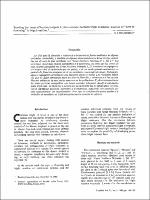| dc.contributor.author | Tara Mohan, S. | |
| dc.date.accessioned | 2022-12-02T17:23:37Z | |
| dc.date.available | 2022-12-02T17:23:37Z | |
| dc.date.issued | 1981-04 | |
| dc.identifier.uri | https://repositorio.catie.ac.cr/handle/11554/12164 | |
| dc.description.abstract | Los días para la floración y resistencia a la bacteriosis fueron analizados en algunas variedades comerciales, y también en algunas líneas resistentes a la bacteriosis, obtenidas por el cruce de esas variedades con "Great Northern Nebraska n° 1, Sel. 27". Las variedades comerciales fueron susceptibles a la bacteriosis, en tanto que los cruces de estas mismas variedades con Great Northenz Nebraska 1, 27, resultaron en segregantes con mayor nivel de resistencia que sus padres, y de un modo general mantuvieron su período de floración semejante al de sus variedades comerciales de origen. Entretanto, algunos segregantes presentaron una floración precoz o tardía Los resultados indicaron que no hubo correlación entre los días de floración y tolerancia a la bacteriosis. Mayores evidencias de este hecho aparecen en las poblaciones F2 de cruzamientos entre líneas precoces susceptibles con lineas normales tolerantes, donde la correlación entre el período de floración y tolerancia a la bacteriosis fue no significativa. Se obtuvieron segregantes precoces, tolerantes a la bacteriosis, sugiriendo este resultado que tales características son recombinables. Este tipo de combinación podrá ayudar a la evolución de variedades de frijol adecuadas para la rotación de cultivos. | es_ES |
| dc.description.abstract | Days to flowering and bacteriosis resistance were analyzed in some commercial varieties, and also in some bacteriosis resistant lines, obtained by crossing those varieties with "Great Northern Nebraska n° 1, Sel. 27". The commercial varieties were susceptible to bacteriosis, while crosses of these same varieties with Great Northern Nebraska 1, 27, resulted in segregants with a higher level of resistance than their parents, and generally maintained their flowering period similar to that of their commercial varieties of origin. The results indicated that there was no correlation between days to flowering and tolerance to bacteriosis. Further evidence of this fact appeared in the F2 populations of crosses between early susceptible lines and normal tolerant lines, where the correlation between flowering time and bacteriosis tolerance was not significant. Early segregants, tolerant to bacteriosis, were obtained, suggesting that such characteristics are recombinable. This type of combination may help in the evolution of bean varieties suitable for crop rotation. | es_ES |
| dc.format.extent | 4 páginas | es_ES |
| dc.language.iso | en | es_ES |
| dc.publisher | Instituto Interamericano de Cooperación para la Agricultura (IICA) | es_ES |
| dc.relation.ispartof | Turrialba; Vol. 31, no. 2 | es_ES |
| dc.subject | PHASEOLUS VULGARIS | es_ES |
| dc.subject | FLORACION | es_ES |
| dc.subject | ROTACIÓN DE CULTIVOS | es_ES |
| dc.subject | CRUZAMIENTO | es_ES |
| dc.subject | PHASEOLUS VULGARIS | es_ES |
| dc.subject.other | Sede Central | es_ES |
| dc.title | Cruzamiento del frijol (Phaseolus vulgaris L.) para inducir resistencia a la bacteriosis: relación entre "días a la floración" y reacción a la bacteriosis | es_ES |
| dc.title.alternative | Breeding dry beans (Phaseolus vulgaris L.) for common bacterial blight resistance: relation of days to flowering to blight reaction. | es_ES |
| dc.type | Artículo | es_ES |
| dc.identifier.status | openAccess | es_ES |


